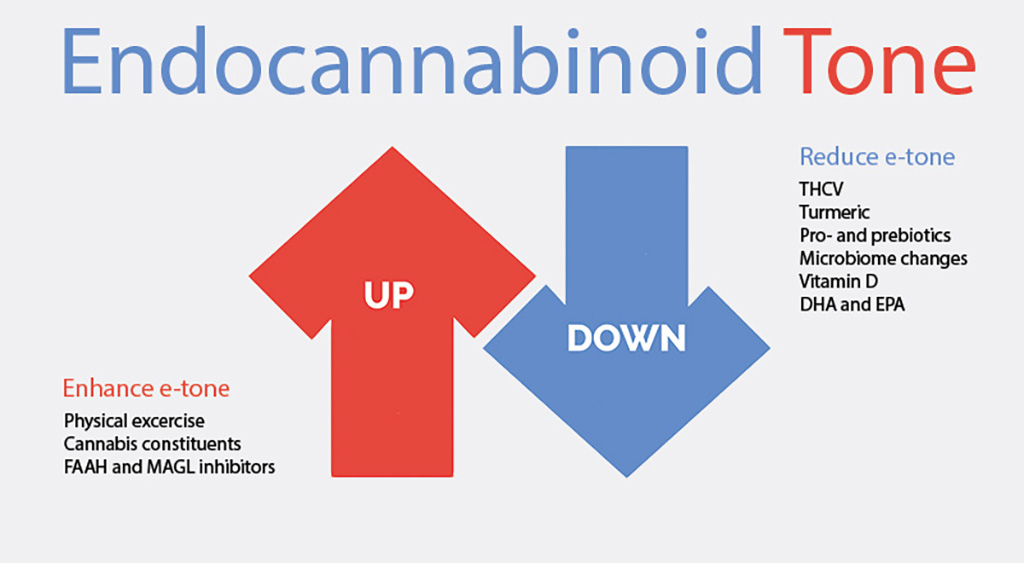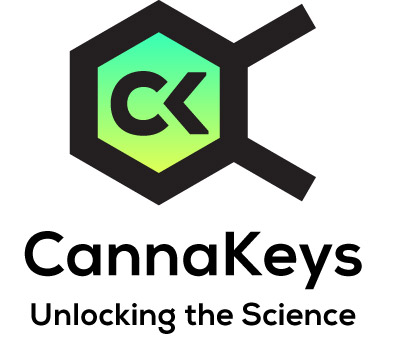In general, endocannabinoid tone (e-tone) is defined by the number of expressions of endocannabinoid receptor sites, the presence of their corresponding endocannabinoids and their degrading enzymes, and their combined functional activity or effects on the organism. An imbalance in e-tone can make a person susceptible to disease, reduce resilience, and diminish the quality of life.

To better describe this relatively new concept of e-tone, let me use another example studied much longer and well-integrated into modern medicine: vagal tone (v-tone).
The vagus nerve descends from the brain’s evolutionarily oldest, lowest part, the medulla oblongata. It hugs the carotid artery through the neck until it reaches the heart and abdomen. The vagus nerve is a critical component of the parasympathetic/autonomic nervous system that continuously regulates the natural resting states of the heart, lungs, endocrine glands, digestive organs, and even the workings of some human psychology and behavior at any given moment.
Here are some facts about the vagal tone that may help illuminate the use and meaning of e-tone:
- V-tone is subjective, and it is continuous.
- V-tone changes in direct reaction to internal and external environmental signals.
- V-tone aims to find balance or homeostasis. It does so by inducing rest, digestion, and relaxation in direct contrast to fight, flight or freeze reactions.
- V-tone, while omnipresent, cannot be measured directly. However, its effects are noticeable. For instance, a higher vagal tone slows the heart.
- Like the effects of anandamide (D. Piomelli et al., 2006),1 higher v-tone has been associated with psychological components such as increased empathy (L. Diamond et al., 2011).2
E-tone refers to the functional reach of the ECS system, which includes psychological components. While endocannabinoids are chemicals that can travel to specific locations in the human body, molecular-model research predicts that endocannabinoids can also interact and produce biological changes without traveling to another receptor site. In other words, (endo)cannabinoids can change their environment by their presence alone. This steady impact (also termed lateral diffusion) resulting from their mere presence can serve as a working definition of endocannabinoid tone (A. Howlett et al., 2011).3 For instance, cells release anandamide under different circumstances and by different guiding mechanisms, one of which is endocannabinoid tone (H. Wang et al., 2006).4
Physiologically, e-tone is regulated in two ways: by the mechanisms of endocannabinoid production; and by their inactivation due to transport and breakdown (A. Howlett et al., 2011).5 Since THC and CBD are cannabinoids that affect the mechanisms by which e-tone is regulated, it is likely that both may also influence, change, and shift e-tone. Why does it matter?
It matters because novel research insights are beginning to describe several specific conditions that respond to e-tone. In other words, a patient-specific imbalance in e-tone can play a significant role in the clinical setting and influence patient outcomes for the better or worse. E-tone may make individuals more vulnerable to developing certain diseases. For instance, tonal imbalances are associated with obesity, metabolic syndrome, diabetes (L. Demizieux et al., 2016), 6 anorexia nervosa (R. Collu et al., 2019),7 migraine, fibromyalgia, schizophrenia, and neurological conditions such as multiple sclerosis (MS), Huntington’s disease, autism (ASD) and others (Y. Haviv et al., 2022).8
Furthermore, research results demonstrate a cause-and-effect relationship between the intestinal microbiome and the eCBome with potential clinical relevance (C. Manca et al., 2020).9
For more information about which patient population is affected by an up- or down-regulated e-tone, check out endocannabinoid tone excessive and endocannabinoid tone deficient.
Endnotes:
1. Piomelli D, Tarzia G, Duranti A, Tontini A, Mor M, Compton TR, Dasse O, Monaghan EP, Parrott JA, Putman D. Pharmacological profile of the selective FAAH inhibitor KDS-4103 (URB597). CNS Drug Rev. 2006 Spring;12(1):21-38.
2. Diamond LM, Fagundes CP, Butterworth MR. “Attachment style, vagal tone, and empathy during mother–adolescent interactions.” Journal of Research on Adolescence. (2012). 22 (1): 165–184.
3. Allyn C Howlett, Patricia H Reggio, Steven R Childers, Robert E Hampson, Nadine M Ulloa, and Dale G Deutsch. Endocannabinoid tone versus constitutive activity of cannabinoid receptors. Br J Pharmacol. 2011 Aug; 163(7): 1329–1343.
4. Wang H, Xie H, Guo Y, Zhang H, Takahashi T, Kingsley PJ, Marnett LJ, Das SK, Cravatt BF, Dey SK. Fatty acid amide hydrolase deficiency limits early pregnancy events. J Clin Invest. 2006 Aug;116(8):2122-31.
5. Allyn C Howlett, Patricia H Reggio, Steven R Childers, Robert E Hampson, Nadine M Ulloa, and Dale G Deutsch. Endocannabinoid tone versus constitutive activity of cannabinoid receptors. Br J Pharmacol. 2011 Aug; 163(7): 1329–1343.
6. Demizieux L, Piscitelli F, Troy-Fioramonti S, Iannotti FA, Borrino S, Gresti J, Muller T, Bellenger J, Silvestri C, Di Marzo V, Degrace P. Early Low-Fat Diet Enriched With Linolenic Acid Reduces Liver Endocannabinoid Tone and Improves Late Glycemic Control After a High-Fat Diet Challenge in Mice. Diabetes. 2016 Jul;65(7):1824-37.
7. Collu R, Scherma M, Piscitelli F, Giunti E, Satta V, Castelli MP, Verde R, Fratta W, Bisogno T, Fadda P. Impaired brain endocannabinoid tone in the activity-based model of anorexia nervosa. Int J Eat Disord. 2019 Nov;52(11):1251-1262.
8. Haviv, Yaron, Olga Georgiev, Tal Gaver-Bracha, Sharleen Hamad, Alina Nemirovski, Rivka Hadar, Yair Sharav, Doron J. Aframian, Yariv Brotman, and Joseph Tam. 2022. “Reduced Endocannabinoid Tone in Saliva of Chronic Orofacial Pain Patients” Molecules 27, no. 14: 4662.
9. Manca C, Boubertakh B, Leblanc N, Deschênes T, Lacroix S, Martin C, Houde A, Veilleux A, Flamand N, Muccioli GG, Raymond F, Cani PD, Di Marzo V, Silvestri C. Germ-free mice exhibit profound gut microbiota-dependent alterations of intestinal endocannabinoidome signaling. J Lipid Res. 2020 Jan;61(1):70-85.

